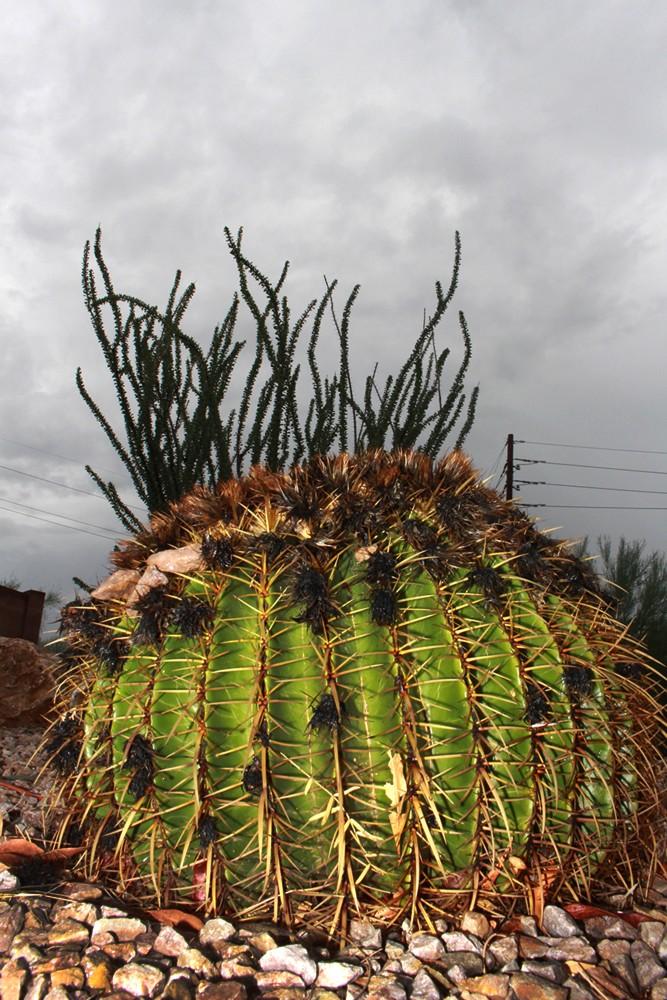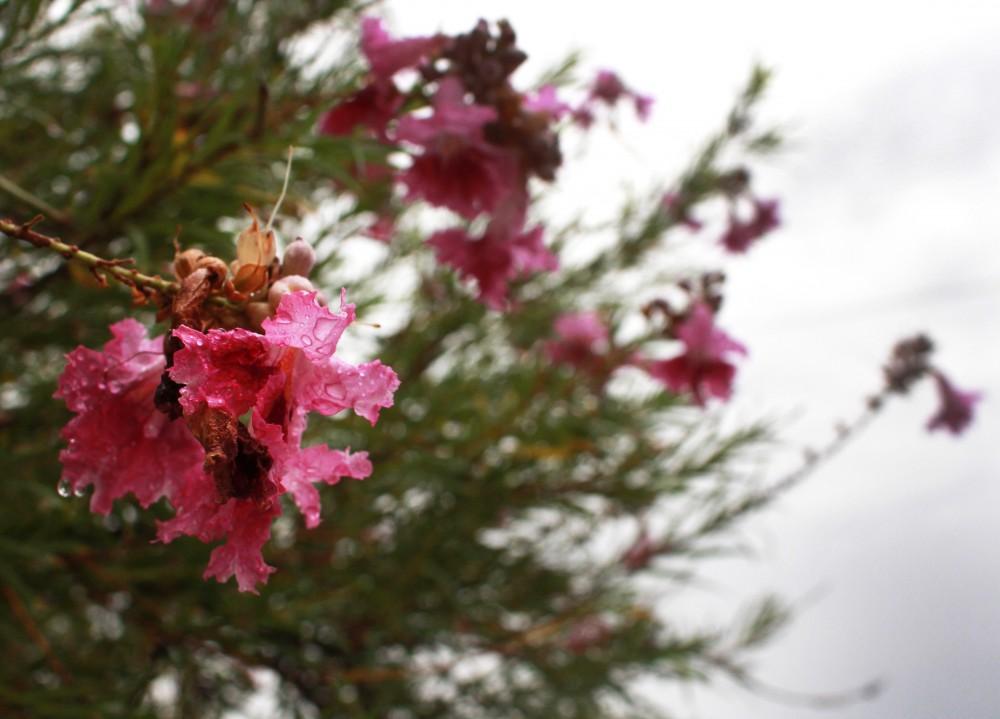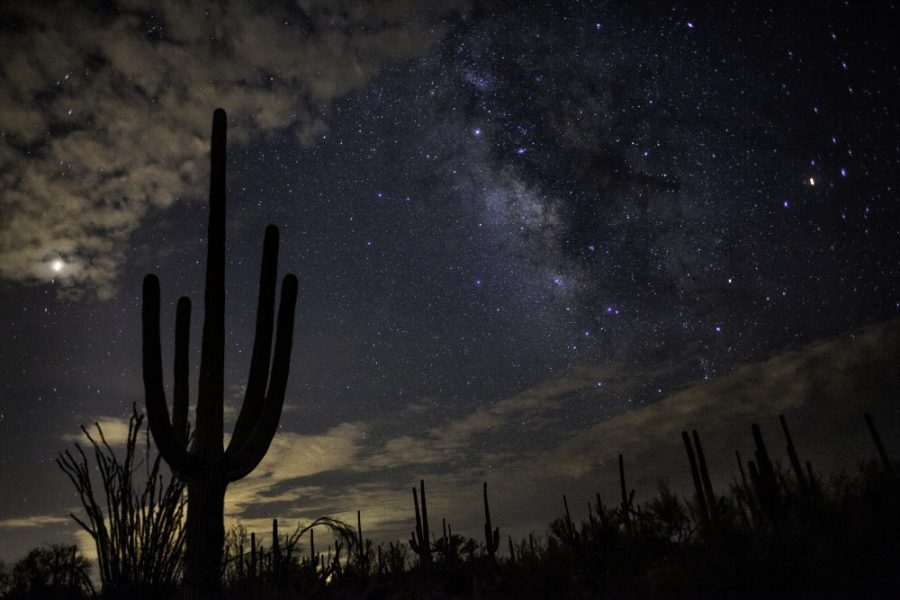The monsoon rains are rolling in with all their tempestuous glory, and the desert is sure to bloom lush and green in the coming weeks, inviting life from the deepest trenches of the Sonoran Desert to celebrate.
Tucsonans know this season well. The monsoons bring about a dynamic time of year that illustrates the duality of nature and life’s relationship with it.
Monsoon season brings whipping winds, pouring rain, flash floods, mosquitos and humidity to the otherwise dry desert, yet desert-folk still welcome it with open arms.
RELATED: New Metaphysical Shop Celebrates the First Day of Summer
“It’s the most dramatic time of the year,” said Thomas Sheridan, a research anthropologist at the Southwest Center and professor of anthropology at the University of Arizona. “The purple clouds and lightning illuminate the entire skyline. I look out my window at the mountains during the monsoon and it’s the greatest light show around.”
Over the past twenty years, Sheridan has been working with the rancher community in Southern Arizona in an effort to bring ranching groups that are often at odds with one another together to work on land and water conservation projects.
“Arizona is a generally arid or semi-arid state, so if you don’t have a reliable source of irrigation water, it’s very difficult to do agriculture out here,” Sheridan said. “So the most widespread use of land is stock raising, primarily cattle ranching.”
According to Sheridan, ranching doesn’t use as much irrigation water as most farming, but this can leave cattle ranches vulnerable in the wake of dry spells. This makes the summer rains imperative, and with Arizona several years into a significant drought, water scarcity has been a major concern.
“Water is one scarce resource that nobody can do without and because we are an arid and semi-arid region, water is in short supply in the first place,” Sheridan said. “[Ranchers] are pretty much dependent on natural forage so if it doesn’t rain, they may not have enough grass to feed their cattle and they may not have enough water for their cattle to drink.”

Kendall Koesen, the community outreach coordinator at Mission Gardens, offered a different perspective on the scarcity of water in Arizona.
Mission Gardens is a live agricultural museum in the place of the garden once belonging to the San Augustine Mission on the old floodplains of the Santa Cruz river. Its timeline garden features recreations of agricultural techniques from every time period in Tucson.
According to Koesen, there is enough water for everyone to live, but it is used incorrectly.
“We use so much water that we are able to conserve it. If farmers used water more efficiently and lowered their use of it by 10 percent, there would be no question of a water crisis,” Koesen said.
RELATED: DeGrazia’s birthday celebration renews respect for Sonoran culture
Koesen pointed to the long history of agriculture in Tucson as proof that food can be grown reliably here.
“We not only have the longest known period of cultivation in the United States, but we have the earliest evidence of canals being used to irrigate crops in the United States,” Koesen said.
Corn was first domesticated in Tucson about 4,100 years ago, likely after trade with native people in Mexico. Ancient people also domesticated beans, tepary beans, squash, chilies and sunflowers and harvested native plants like panic grass and devil’s claw.
“All of these [crops] grew during the summer. So we had the heat and the floodplains from the Santa Cruz and Gila rivers, which was a great combination,” Koesen said.
The Hohokam and the Tohono O’odham practiced ak-chin agriculture, in which they planted crops in the desert where washes come out of the hills and spread out on the plain. Regular summer rains would cause these washes to flow and water the crops.
“If you’re doing flood-water farming like the Tohono O’odham did west of Tucson, you were totally dependent on the monsoon rains because most of the time there was no water in the arroyo,” Sheridan said.
Although the monsoon rains have certainly influenced farming and agriculture in the Southwest, they have also deeply influenced culture.
“Tucson has always been a multicultural community,” Sheridan said. “There are all these rich traditions around the monsoons that are still prominent today.”

Sheridan outlined San Juan’s Day, which evolved to become linked to the monsoons when the Spaniards brought their traditions to the Southwest.
One of those traditions that existed long before the arrival of Europeans and still exists today is the harvest of Saguaro fruit, a Tohono O’odham tradition, which comes to a climax just before the monsoons are welcomed to the desert.
“[The monsoons are] usually the last thing to come,” said Tina Andrew, an ancestral ranger at Saguaro National Park. “The fruit is ripe and many of them have opened up, and then when the rain hits it and it’s hot the next day, most of the fruit spoils.”
Andrew grew up in a reservation village called Ghaka, where she spent much of her free time enjoying the outdoor world. She grew up harvesting the Saguaro fruit, or bahidaj, every year.
The Tohono O’odham rise before the crack of dawn and pick fruit until not long before midday. Using Saguaro rib picking poles, Andrew and others would knock off a few fruits from every cactus and toss them in a bucket.
At the end of the harvest day, Andrew brought the sugar-sweet fruit to her grandmother, who fermented it to create ceremonial wine used to welcome the monsoon rains.
“Looking at it from a spiritual point of view — harvesting the fruit, then processing the fruit to create the ceremonial wine and then using the ceremonial wine, through song and dance, to call the rains in — it’s not only important to us and the native crops, but we understand that it’s important to all life,” Andrew said.
For that reason, the Tohono O’odham don’t harvest all the fruit on each Saguaro and they don’t pick them the day they ripen either.
“For O’odham, we’ve always understood the process that it’s important not to take all of the fruit,” Andrew said. “Even before we picked, when the fruit was ripe, we don’t go out there right away. We were always told that you let the animals take first because they are the ones responsible for spreading the seeds.”
It means a lot to Andrew that the Saguaro National Park allows her people to continue this tradition on their ancestral land.
“During the monsoons, there is just an explosion of life, and it’s important that we understand that the water gives that life to us, the plants and the animals,” Andrew said.
Follow Daily Wildcat on Twitter









